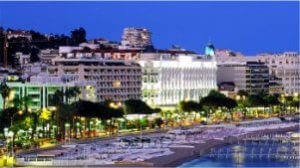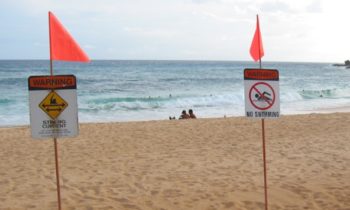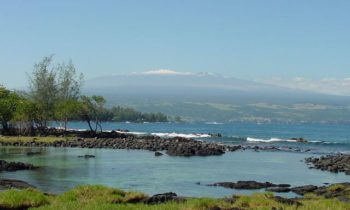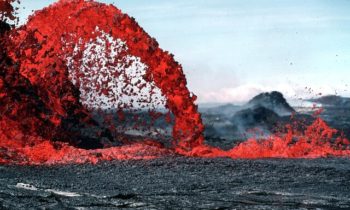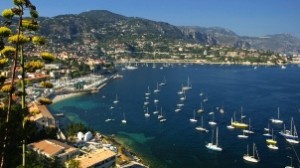 I have never been disappointed with my experiences while in France, especially the French Riviera. I have had some interesting interchanges with the people in these countries, spent a few lost hours driving around Paris, and a few unique food experiences, but all in all these experiences make traveling though these countries more worth while. In this article we will focus on the French Riviera part of these countries, although one could spend a few years enjoying the history, people and geography of both these countries.
I have never been disappointed with my experiences while in France, especially the French Riviera. I have had some interesting interchanges with the people in these countries, spent a few lost hours driving around Paris, and a few unique food experiences, but all in all these experiences make traveling though these countries more worth while. In this article we will focus on the French Riviera part of these countries, although one could spend a few years enjoying the history, people and geography of both these countries.
If you are wondering what’s the difference between the French Riviera and the Italian Rivera then you have come to the right place. The French Riviera (which is quite a bit more popular) makes up about 115 KM (71M) of coastline and beaches, 300 days of sunshine, 18 golf courses, 14 ski resorts, and 3000 restaurants. I have driven along the entire coastline and compared to the Italian Coast it is flat as a pancake (until you venture inland).
The drive along the coast between Toulon and Nice is quite easy-going and relaxing. However when you get closer to the city-state of Monaco everything changes. You will need to be prepared to drive through a long and windy set of coastal roads, that go thorough more tunnels (steep mountains/cliffs) and long high bridges (over steep valleys) than one could count. However the cities of Genova and La Spezia are worth the drive especially if you get the chance to visit the five coastal villages of the Cinque Terra.
 It depends on how much time you have and how much traveling you want to do, but if you would like to experience a short time at various locations than you would need at least 2 weeks. When it comes to enjoying the Rivera there are a number of ways including: renting a car, jumping on trains, relaxing in a tourist bus, bouncing along in a local bus, riding a bicycle or motorcycle, and cruising along the ocean in a cruise ship, yacht, or tourist boat.
It depends on how much time you have and how much traveling you want to do, but if you would like to experience a short time at various locations than you would need at least 2 weeks. When it comes to enjoying the Rivera there are a number of ways including: renting a car, jumping on trains, relaxing in a tourist bus, bouncing along in a local bus, riding a bicycle or motorcycle, and cruising along the ocean in a cruise ship, yacht, or tourist boat.
My favorite way to travel in this area is by car or motorcycle. The reason for this is that you are free to get off the beaten track, enjoy countless back roads and scenery, as well as stopping to enjoy a winery, local restaurant, or visit one of the many small villages and towns along the way. Last time I was in the area, I was with my son and we rented a car in Perpignan which was the first train stop from Barcelona.
In my opinion if you want to strictly stay on the coast then you would be better off renting a car in Marseille and starting there since this is really where the Riviera starts. If you would like to visit a few areas inland than renting in Nimes. If you are looking at visiting the most interesting, and in my opinion worthwhile places, than I recommend these routes.
Interesting Cities in the South of France and French Riviera:
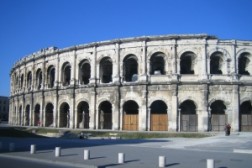 Nimes:
Nimes:
The city of Nimes has a rich history, which dates back to the Roman Empire, when it became a Roman colony sometime before 28 BC. It was Augustus who made the city the capital of the Narbonne province, and gave it all its glory. During the reign of Augustus the old part of town was encircled with a ring of ramparts six kilometers long that were reinforced by fourteen towers and gates of which still two remain to this day.
While in Nimes you should spend a day wondering around the old town (inside the walls) and visit the 1st century Roman Amphitheater which is the best preserved Roman arena in France. A short walk away you can visit the, Maison Carrée (Square House), which is a small Roman temple dedicated to sons of Agrippa built-in 19 BC, and it is by far one of the best-preserved Roman Temples anywhere. If you visit you can watch a short film about the history of Nimes inside the temple. There are also many small cafes, restaurants, old walls, gates and myriads of streets and shops to visit while inside the old city.
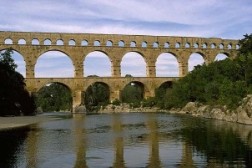 Pont du Gard:
Pont du Gard:
After you leave Nimes the next must see stop would be the awesome Pont du Gard aqueduct. It is only 20 km north-east of the city and a nice drive. This aqueduct not only served to carry water across the Gardon River Valley, but also served as a main roadway for ancient roman travel. It is well worth the visit and should by no means be missed for any reason. If you arrive in the summer months you can spend the day resting on the river beaches, swimming in the river all while sitting under and looking one of the most magnificent feats of ancient engineering still in existence today.
Avignon:
Avignon is a short drive away from Nimes and is situated on the left bank of the Rhône River, about 85 km (52.8 mi) north-north-west of Marseille. Avignon occupies a large oval-shaped area, not fully populated and covered in great part by parks and gardens. The city is famed for many years as the second home for the pope as the Vatican substitute in France. The city is also famous for its huge walls, ramparts and 39 massive towers built by the popes of the 14th century. These walls represent one of the finest examples of medieval fortifications that are still in use today.
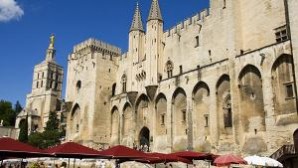 While in Avignon make sure to visit the Palais des Papes (“Papal Palace”) which is an impressive monument which sits within a square of the same name. The palace was begun in 1316 by John XXII, and continued by succeeding popes through the 14th century. Within walking distance is the Notre Dame des Doms, the cathedral, which is a Romanesque building, mainly built during the 12th century. The most prominent feature of the cathedral is the gilded statue of the Virgin which surmounts the western tower.
While in Avignon make sure to visit the Palais des Papes (“Papal Palace”) which is an impressive monument which sits within a square of the same name. The palace was begun in 1316 by John XXII, and continued by succeeding popes through the 14th century. Within walking distance is the Notre Dame des Doms, the cathedral, which is a Romanesque building, mainly built during the 12th century. The most prominent feature of the cathedral is the gilded statue of the Virgin which surmounts the western tower.
Right down from the Papal Palace you can find the Pont Saint-Bénézet which is the cities famous 12th century bridge that abruptly ends in the middle of the river. Before you leave don’t miss the Antiquaire quarter, or the Chemin de Ronde, which will take you to the top of the ramparts. From here one can understand why the site was chosen for a fort since it stands high above the immense plains of the Rhône River which makes it a strategic point of the whole valley.
French Riviera:
From Avignon you can choose various smaller roads or the main toll road to take you to Marseille to begin your French Riviera experience.
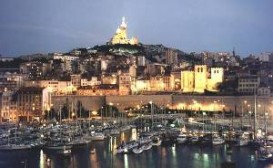 Marseille:
Marseille:
Marseille is France’s largest city and commercial port on the Mediterranean coast, as well as second most populous area of France, after Paris. Marseille is listed as a major centre of art and history, and has many museums and galleries and there are many ancient buildings and churches of historical interest. Most of the attractions, and shopping areas, are in central Marseille.
The Old Port or Vieux-Port is the main harbor and marina of the city and is guarded by two massive forts and a beautiful lighthouse. If you enjoy eating, which is a universal activity, then this is where you want to be. There are many cafes, restaurants and a daily fish market along the waterfront area. If you like history then visit the Musée d’Histoire, which is the Marseille historical museum, in the Centre Bourse. It contains records of the Greek and Roman history of Marseille as well as the best preserved hull of a 6th century boat in the world.
If you like fashion then the Musée de la Mode museum is the place for you. The museum has an interesting display of over 2000 clothing designs from the last 30 years. For those who love modern art go to the Musée Cantini, a museum of modern art near the Palais de Justice. It houses artworks associated with Marseille as well as several works by Picasso. One of my favorite places is the Abbey of Saint-Victor which is one of the oldest places of Christian worship in Europe. Its 5th century crypt and catacombs occupy the site of a Hellenic burial ground, later used for Christian martyrs and venerated ever since. From Marseille you can drive along the coast and see the beautiful coastline of the French Riviera and the beautiful Mediterranean shores.
From here you could visit the larger cities of Toulon and Cannes, or the smaller coastal towns of Le Lavandou, Cavalaire, St. Tropez, St Raphael, and Le Trayas. Every one of these smaller cities has their own unique attractions, beaches, and cultural diversities.
Toulon:
Toulon is a large military harbor town with a large naval museum with as many festivals, markets, museums, beaches and water activities for those who love the ocean. It is a charming place, with lots of touristy things to do. However the small fishing town of Cannes has grown up into quite the tourist mecca.
Canes:
If you love music, film, tourist activities, luxury shops, restaurants, hotels and beautiful beaches than Cannes is the place for you. The Canes film festival is usually held sometime in May and for film buffs it is the must thing to do before you die.
 If you’re looking for old historical things to see than Canes is not really a place to go. Just 150 years ago this area was not much more than a small fishing village, but over the years it has grown to be one of the must see places in the south of France and french riviera. You can get to the top of the city by climbing the Mont Chevalier up to the Suquet to see the panoramic, breath-taking view of the whole city and the Lérins Islands. A few other places to see is the Rue Meynadier Street which has about any shopping experience one could imagine.
If you’re looking for old historical things to see than Canes is not really a place to go. Just 150 years ago this area was not much more than a small fishing village, but over the years it has grown to be one of the must see places in the south of France and french riviera. You can get to the top of the city by climbing the Mont Chevalier up to the Suquet to see the panoramic, breath-taking view of the whole city and the Lérins Islands. A few other places to see is the Rue Meynadier Street which has about any shopping experience one could imagine.
The Palais des Festivals is a fabulous structure which holds the International Film Festival, congress of record producers, and many concerts for classical music, dance and theater. There are even four casinos here as well. One of the most famous Promenades in the world can be found at the Croisette. This three kilometers area follows the curve of the bay and you can see many flowering gardens, lawns planted with palm trees, umbrella pines and other trees all the way to Port Canto, Palm Beach and a sea water health spa. Strollers can find their way back to the center by taking the renowned rue d’Antibes.
There are many other places to visit when you are in the area and they all have their own unique charms and special features. However I recommend that you finish your visit (or keep on driving to hit Italy) and visit my next exciting stop.
After you can leave Canes and the French Riviera Behind, you can continue up the coast and visit an entire country in just one stop. You can do this by visiting the city of Monte Carlo (officially known as the city-state of Monaco). Visit our Monaco Feature on OMD Travel, Europe Addition:

